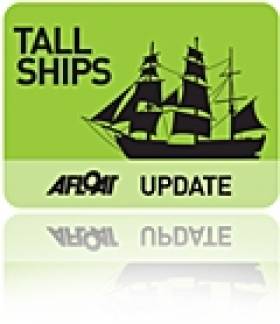Displaying items by tag: Cuauhtemoc
Italian Navy Tallship Makes An Impressive Entrance
#TALLSHIPS – The Italian Navy's full-rigged training ship, Amerigo Vespucci, made a lunchtime arrival to Dublin Port today, where she then proceeded to make an impressive entrance through the East-Link bridge, in order to reach her 'Docklands' berth, writes Jehan Ashmore.
She had earlier appeared on the horizon south of the Kish Bank Lighthouse and what makes her easy to recognise is her distinctive hull livery. Unlike most white-painted tallships, the three-masted ship sports striking black and white hull, with each strip marking one of her three decks. Standing above these decks are her rigging, where her masts tower above the seas and at a height of nearly 63 metres.
Prior to her arrival, another naval sail training ship, the barque Cuauhtemoc, of the Mexican Navy docked into the capital having made a late morning call. A week ago she became the first over the finishing line off the Tuskar Rock, marking the final leg of the race from Spain.
Looking particularly smart, the vessel was 'dressed overall' upon her arrival with a large Mexican flag flying proudly at the stern. She too passed through the East-Link bridge and like Amerigo Vespucci, is moored alongside Sir John Rogersons Quay.
Astern of her was the UK flagged gaff ketch Maybe which has been in Howth Harbour in recent days. She berthed opposite the Cuauhtemoc at North Wall Quay.
A total of nine Tall Ships will have free access to the public at different times over the weekend, available on a first come first served basis.
In regards to the Amerigo Vespucci, she will be open today, from 3pm to 7pm, and tomorrow from 10.30am to 1pm and 3pm to 6pm. On Saturday the times are from 10.30am to 1pm and 3pm to 7pm.
Opening hours for the Cuauhtemoc, will be open till 7pm today, and from 10am till 11pm tomorrow and Saturday. For the full list of vessels and respective opening hours visit www.dublintallships.ie/fleet/
A notable festival highlight, is the 'Crew Parade' which is on tomorrow (Friday) between 3-4pm. Crews from around the world will march from the North Wall Quay and finish at the Custom House for a special prize giving ceremony.





























































